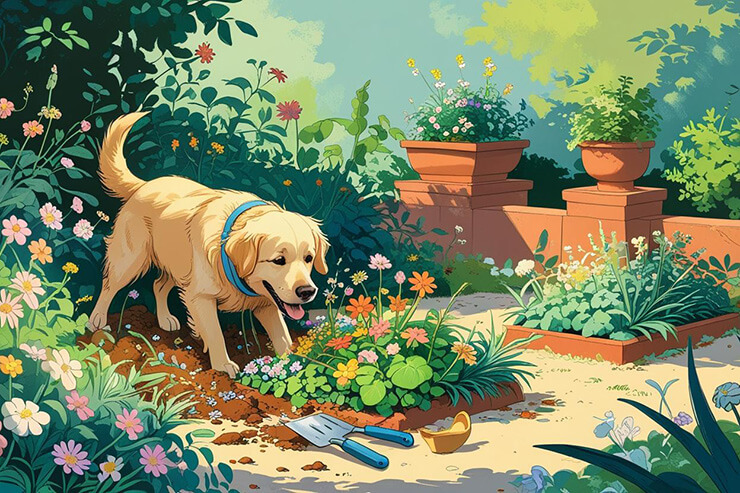Read by Matilda Longbottom

They say people and their dogs tend to resemble each other, sharing not just looks but quirky traits and habits, too. A stroll through the dog park often makes you wonder, “Who’s paired with that goofy golden retriever splashing in the puddle? And who’s the match for that serious-minded, steady bullmastiff?”
This got me thinking, what if the same theory applied to gardeners and their gardens? Oh, dear.
One day, my husband’s British friend admired our back garden, which I had lovingly dug, planted, and expanded around a towering mullein. “That’s quite an English garden,” he remarked. I glowed with pride—until I read what that actually meant.
Apparently, the English-garden style was a reaction to the rigid, geometric French gardens, where everything’s lined up with military precision. English gardens, on the other hand, embrace nature’s whims, blending seamlessly with the surrounding landscape. They’re informal, natural, and somehow structured to look delightfully unstructured. My garden? It definitely had the “natural” part down, but the structure? Let’s just say, it’s a bit more “before” than “after” in the world of makeover shows.
But I still smile when I see the bright false sunflowers, the twirling daylilies, and the spiky coneflowers in my garden. The vibrant pinks, oranges, and yellows create a cheery, if slightly chaotic, palette. Sure, it’s a mess—but it’s a happy mess.
Where there’s order, credit goes to my husband, Carl. He’s the master behind the tidy hanging baskets brimming with wave petunias, lobelia, sweet-potato vine, and geraniums. His rock garden, with its carefully arranged succulents and proud purple allium, is a sight to behold. And those sky-blue morning glories climbing the trellises? Carl’s handiwork. In contrast, my gardening style is more of a scattershot approach. Sigh.
So, how did my garden end up like this? I blame fatigue, a tight budget, and a soft spot for “rescue” plants. In an effort to cut down on weeding without splurging on mulch, I planted periwinkle—everywhere. And those half-wilted plants I couldn’t resist at the grocery store’s clearance sale? They spent a few days neglected in the driveway before I finally found a spot in the garden for them.
A critical eye might see weeds poking up defiantly and my relentless periwinkle choking out anything that dares to grow. But amidst the wild chaos, there’s a certain charm. It’s a garden that’s alive, even if it’s not picture-perfect.
Let’s not even talk about my “vegetable” garden, which is really just a home for chives, oregano, and mint—the hardy survivors. Zucchini and spinach? They come here to perish. Another nice mess I’ve gotten myself into, as Oliver Hardy might say.
Why do I keep trying? My brothers are both fantastic gardeners, each with immaculate, thoughtfully planned gardens that could grace the pages of any garden magazine. Jamie and his wife, Glenda, are so serious about gardening that they helped start a community garden, where they grow everything from arugula to zucchini. Their backyard is an idyllic retreat, with dappled light, carefully placed shrubs, and a birdbath that attracts a chorus of cheerful songbirds.
Brian and his wife, Deborah, transformed the forested area around their home into a magnificent garden. They bravely battled poison ivy—Brian’s kryptonite—pulling it up by the roots to create a peaceful haven with stone paths, a gazebo, and artfully arranged flowers and shrubs. Deborah calls it her happy place, and it’s easy to see why.
So, why do I persist with my messy garden? Because, despite its flaws, it brings me joy. There’s a thrill in seeing a struggling cinquefoil suddenly burst into bloom, or watching Russian sage take over a neglected corner with its purple splendor. And then there are the surprises—a hidden cucumber, cherry tomatoes ripening under a leafy canopy—that make it all worthwhile.
Sure, my garden might be a Darwinian experiment gone awry, filled with rescues, misfits, and plants that somehow survived my care. But each one has a story, and I’m rooting for them all.
And now, if you’ll excuse me, our golden retriever has decided that the alyssum bed is the perfect place to bury her tennis ball. Just another day in the life of this perfectly imperfect garden. ❖
About the Author: Martha Morris is a retired educator who delights in the quirky charm of gardens that march to the beat of their own drum. She enjoys introducing her grandchildren to the wonders of the natural world, whether it’s through a trip to the local organic farm or a romp through her delightfully chaotic garden. Martha is the author of the picture book “Katherine and the Garbage Dump” and co-author of the guidebook “The Road to Canada’s Wilds.” She believes that every garden has a story, and sometimes, the messier the garden, the better the tale.


 Previous
Previous

